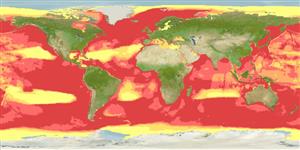Common names from other countries
Classification / Names / Names
ماع يماسا | فدارتم | Catalog of Fishes (gen., sp.) | ITIS | CoL | WoRMS
Environment: milieu / climate zone / depth range / distribution range
يسانش موب
یز حطس; ور سونایقا (Ref. 75906); قمع تارييغت 0 - 616 m (Ref. 83346). Tropical; 90°N - 90°S, 180°W - 180°E
Circumglobal. [Arabian Sea population: EN, D; Oceania population: EN, A1ad: IUCN 2010 (Ref. 84930)].
Length at first maturity / Size / Weight / نس
Maturity: Lm ? range ? - ? cm Max length : 1,890 cm TL يسنج صاوخ نودب / رن سنج; (Ref. 936); هدش شرازگ نزو هنيشيب: 35.0 t (Ref. 1394)
They migrate from tropics (breeding areas) to polar or sub-polar regions, reaching the ice edges in both hemispheres (feeding areas); their migrations take them through oceanic zones (Ref. 1394). Maximum depth from Ref. 122827. Feed and breed in coastal waters, often near human population centres, and this helps make them one of the most familiar of the large whales. Feeds on krill and small schooling fish (Ref. 1394). According to a study in the Philippines, Babuyan Islands (121°36’00", 19°18’00) was verified as a breeding ground for this species, and humpback whale songs were recorded during this season. Social groups observed were lone adult, mother-calf pairs, two adults, mother-calf-escort, and a surface active mating group of 3 to 4 individuals (Ref. 77119). Adults length 1600 cm in Ref. 1394. Threats to this species are dynamite and cyanide fishing, pollution, and intrusion of foreign commercial fishing vessels (Ref. 77119), unregulated fishing activities of Taiwanese vessels, i.e. long-line and drift net fishing, and unconfirmed reports of pirate whaling (Ref. 77118). There were nine distinctive themes of humpback whale songs identified wherein 7 of which were common in the Philippines and Hawaii (Ref. 77118). Feeds and breeds in coastal waters, often near human population centres, and this helps make them one of the most familiar of the large whales. They migrate from tropics (breeding areas) to polar or sub-polar regions, reaching the ice edges in both hemispheres (feeding areas); their migrations take them through oceanic zones (Ref. 1394). They pefer warm shallow waters to breed, usually near offshore reefs, islands, or continental shores. Feeding grounds are characterized by cold, productive, shallow waters (Ref. 122680). Feeds on krill and small schooling fish (Ref. 1394). According to a study in the Philippines, Babuyan Islands (121°36’00", 19°18’00) was verified as a breeding ground for this species, and humpback whale songs were recorded during this season. Social groups observed were lone adult, mother-calf pairs, two adults, mother-calf-escort, and a surface active mating group of 3 to 4 individuals (Ref. 77119).
Life cycle and mating behavior
غولب | لثم دیلوت | یزیر مخت | اه مخت | Fecundity | )ورال ( دازوت
Babuyan Islands (121°36’00", 19°18’00"), Philippines was verified as a breeding ground for this species. During this season social groups observed were lone adult, mother-calf pairs, two adults, mother-calf-escort, and a surface active mating group of 3 to 4 individuals (Ref. 77119). Associated activities involved cows with young calves escorted by males, aggressive competitive behavior, and singing (Ref. 78067).
یلصا ذخآم
عجارم | هدننك گنهامه | ناراكمه
Jefferson, T.A., S. Leatherwood and M.A. Webber. 1993. (Ref. 1394)
NCUI زمرق تسرهف رد تيعضو (Ref. 130435)
ستياس رظن زا تيعضو (Ref. 108899)
یناسنا هدافتسا
تاليش – يريگ يهام: يراجت
FAO - تاليش – يريگ يهام: landings, هنوگ هيامن | FishSource | Sea Around Us
اهرازبا
يتنرتنيا عبانم
Estimates based on models
Preferred temperature
(Ref.
115969): 0.2 - 10.2, mean 1.8 (based on 43796 cells).
یگدنهج
دايز, هام 51 زا رتمك ، تيعمج ندش ربارب ود يارب مزال نامز هنيمك (K=0.25-1.96; tm=6).
یريذپ بيسآ
High vulnerability (56 of 100).
تميق هقبط
Unknown.
